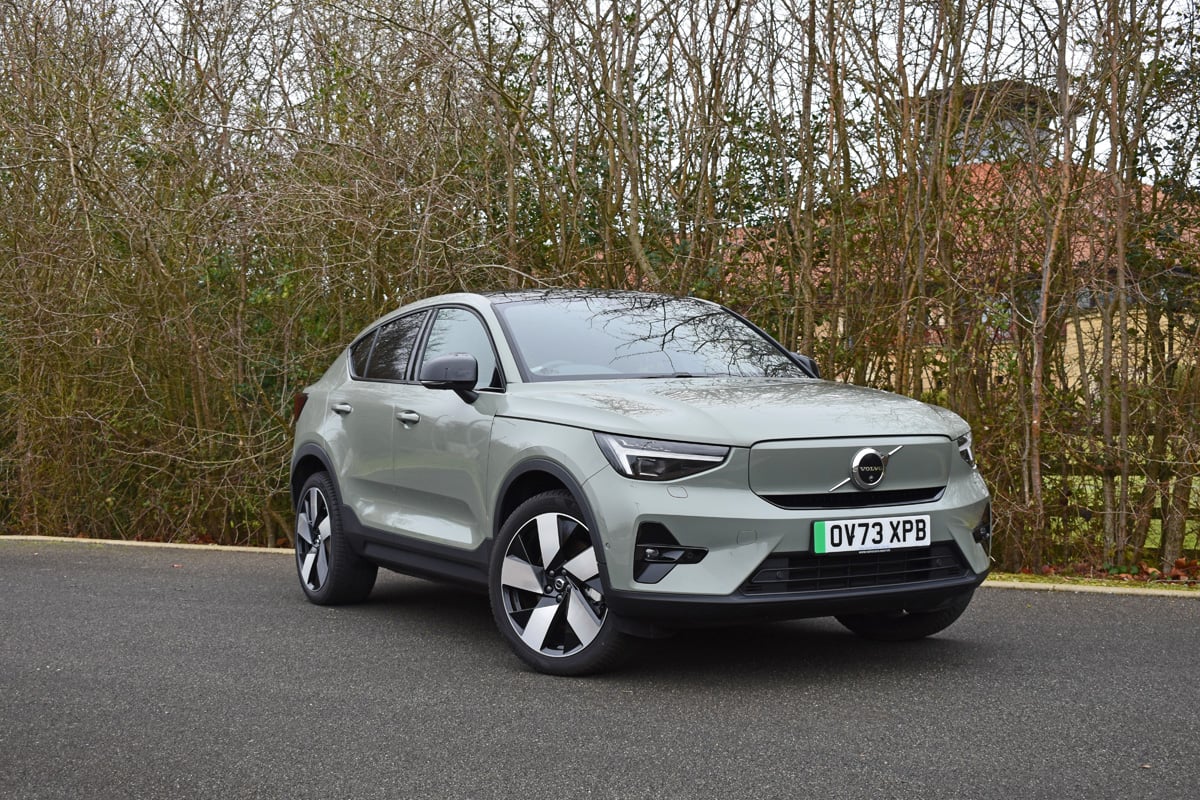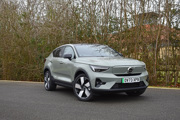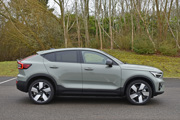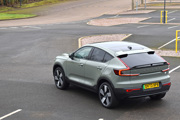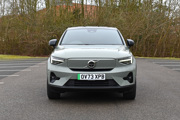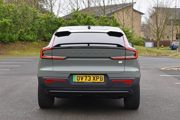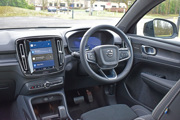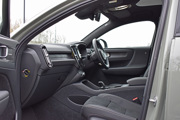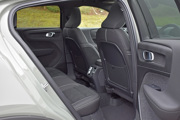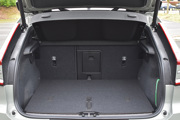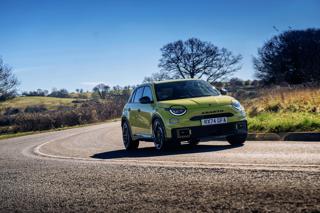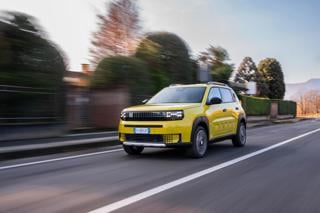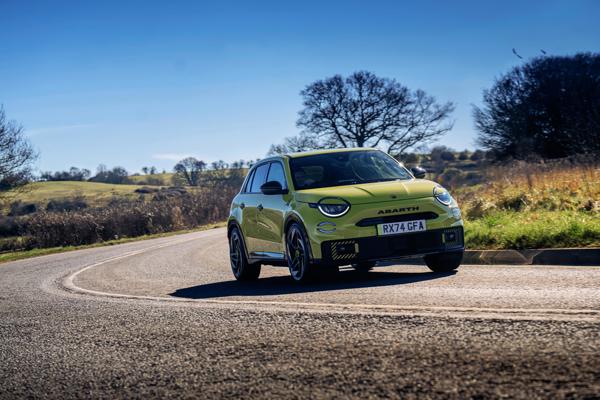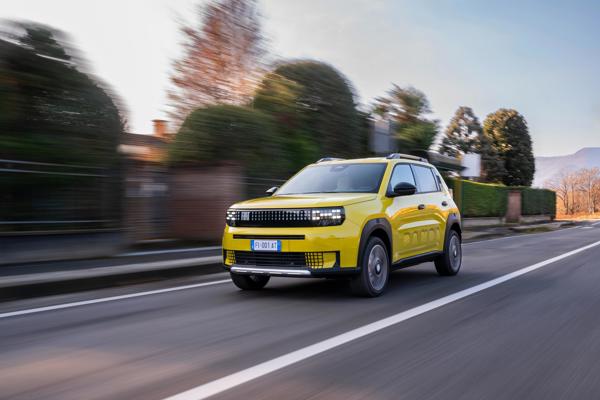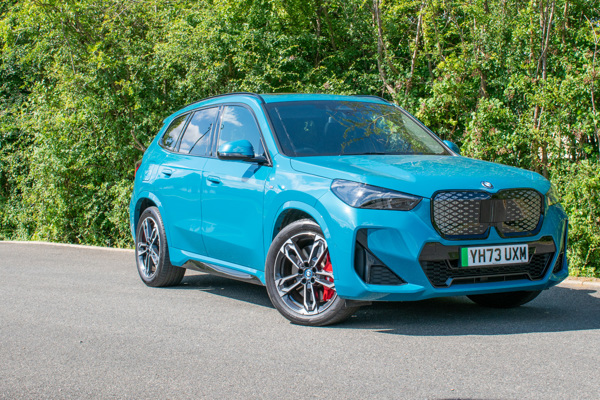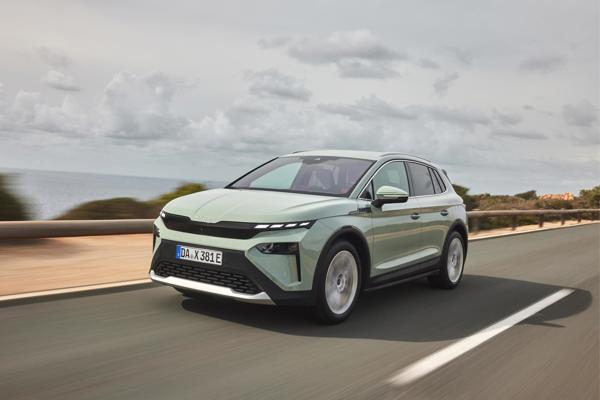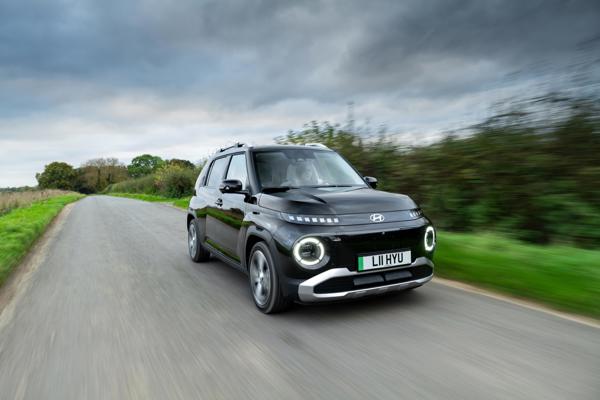Review
I was fortunate to run our long-term Volvo XC40 Recharge long-termer, so was more than happy when I was given the keys to our C40 for its final few weeks on the Fleet News fleet.
As expected, much of it was very familiar – it still offers the same refinement, premium quality and ride comfort which I was so impressed with – but there were a couple of crucial differences.
Firstly – and the most obvious from the outside – is the body shape. While the XC40 is a traditional SUV with a fairly upright back, the C40 is much more of an SUV coupe, with its steeply sloping tailgate.
On the negative side, this obviously impacts practicality. This was highlighted when I used it to help a friend move house. While it still has a decent boot capacity – 404 litres with the seats in place, 48 less than the XC40 – its sloping rear windscreen stops it from carrying the bulky loads its sibling swallows with ease.
On the positive side, the boot lip is level with the floor of the boot and when the rear seats are folded down, it creates a flat floor so loading and unloading long items is easy.
Apart from the looks, the other impact of the coupe bodystyle over the XC40 is its improved aerodynamics.
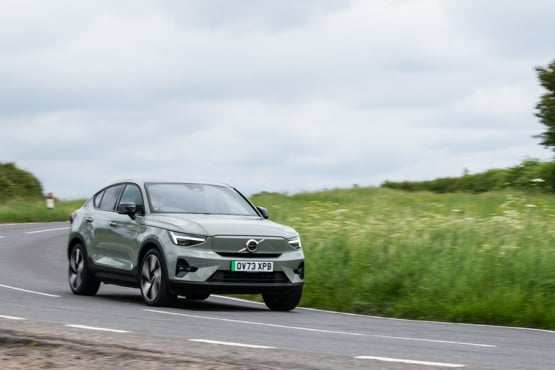
This leads to better efficiency which is also increased by the other major change. Our XC40 was one of the last models produced by Volvo with the front-wheel drive 234PS powertrain before it introduced its new 241PS rear-wheel drive drivetrain in the single-motor variants.
This saw the XC40’s WLTP range rise from 259 miles to 286 from the same 69kWh battery. The more slippery shape of the C40 increases this by a further 10 miles to up to 296.
During my time with the C40, I was usually getting an indicated 250 to 260 miles range when the battery was 100% charged, with typical efficiency being 3.6 to 3.7 miles per kWh.
This is slightly up on the real-world average of 3.4mi/kWh I achieved with the XC40, although that was over the colder winter and spring months.
Our real-word efficiency does highlight the Volvo powertrain is not the most efficient BEV on the market, but what is more impressive is the overall experience of running the C40.
The cabin design is excellent, comfort levels – aided enormously by its superb seats – are high, while a number of in-life updates and its Google-powered navigation system keeps the car feeling as up-to-date and futureproof as anything else on the market.
Considering the C40 was launched in 2021 - the XC40 arriving three years earlier - this speaks volumes for the overall qualities of the car, which continues to be an impressive package.
Final report by Andrew Ryan.
Running costs compared
It’s a measure of Volvo’s progress from purveyor of safe but lacklustre estates to safe, high quality SUVs and executive saloons that the trio we’ve chosen for running cost comparisons are the premium Polestar 2 (single motor long range), Audi Q4 45 Sportback (single motor) and Mercedes-Benz EQA250+.
WLTP range figures are similar, all approaching 300 miles, and the four cars are well matched when it comes to driving performance and enjoyment: i.e. proficient without necessarily bothering the BMW iX1.
Badge appeal might still slightly go against the Volvo – it takes an age to change brand image and momentum is easily lost with sub-par products – but when basing considerations on the financials (head) rather than emotions (heart), the C40 holds its own.
Take the overall running cost: 66.73ppm puts it in the middle of the pack, falling short of the Polestar’s 61.77ppm but beating the Merc’s 69.60ppm. Put into context, over four years/60,000 miles, the C40 would cost just under £3,000 more than the Polestar 2.
Dig deeper, and the Volvo is the clear winner on SMR costs, at 3.5ppm (next best is the EQA250+ on 4.38ppm).
Depreciation is where you might expect to see the heritage premium brands do best, but the EQA and Q4 fall short, with the latter trailing on 64.03ppm. Polestar 2 heads the group again on 46.16ppm followed by the C40 on 50.44ppm, leaving the EQA250+ in third on 53.61ppm.
All these figures are taken from the Fleet News Company Car Tax Calculator.
It’s an impressive performance by the C40 which has the second highest P11D price, suggesting Volvo is setting the right level of discount. That said, it’s also a reflection of volumes, with the C40 being comprehensively outstripped by the other models in this list.
In the year to end-May, the C40 has sold just 565, compared to the Polestar 2’s 1,719, the EQA’s 2,187 and the table topping Q4’s 3,278.
For fleets considering adding new models to their choice list, the Volvo C40 makes financial sense in this company; but Volvo needs to up its game to win the hearts of the user-chooser.
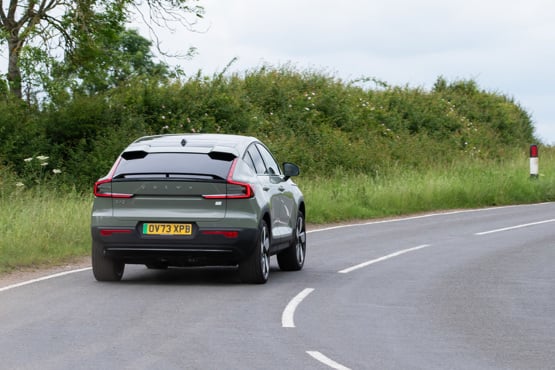
Running cost comparisons:
Volvo C40 – £56,645
- Running cost - 66.73ppm
- Fuel - 12.75ppm
- SMR - 3.5ppm
- Depreciation - 50.44ppm
Polestar 2 (single motor long range) - £52,895
- Running cost - 61.77ppm
- Fuel -10.55ppm
- SMR - 5.06ppm
- Depreciation - 46.16ppm
Audi Q4 45 e-tron Sportback (single motor version) - £54,985
- Running cost - 64.03ppm
- Fuel - 12.32ppm
- SMR - 5ppm
- Depreciation - 64.03ppm
Mercedes-Benz EQA250+ - £57,995
- Running cost - 69.60ppm
- Fuel - 11.61ppm
- SMR - 4.38ppm
- Depreciation - 53.61ppm
Easy to live with
The past few weeks have flown by with the Volvo C40; it’s an easy car to live with.
The range is just about sufficient, although a recent swap into the 300-mile Audi Q4 e-tron did reveal how much I value those extra 50-60 miles. Not just for peace of mind, but also to remove the hassle of charging three or four times per week – especially during the wet weather we’ve had recently. Winding up a sodden cable is a thankless task.
The Volvo has several advantages over most electric cars I’ve driven. First, back to the sodden cable. It’s unpleasant at the best of times, but when you have to wrestle it back into its too-small carrier bag or, alternatively throw despairingly into the boot among other travel items, the annoyance rises threefold.
None of that for the C40 – Volvo has created a handy space beneath the boot to store the cable, minimising the time spent coiling.
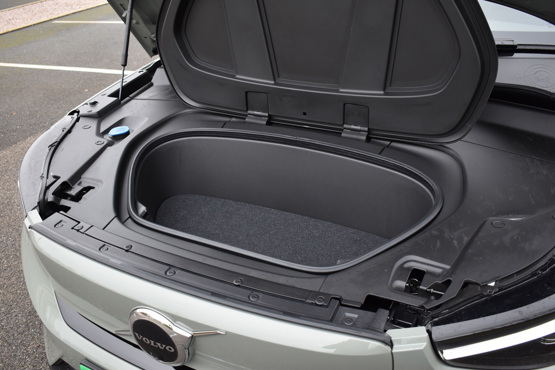
Performance is good with impressive acceleration and decent range, but it’s also well-mannered on the road with decent handling – although arguably a little too firm when tackling the UK’s pock-marked roads.
The C40 is also eye-catching – the body shape stands out from a crowd of me-toos but not embarrassingly so. Several people have commented on its sleek coupe profile.
That, however, brings me to the negatives, the biggest of which is the rear-view visibility. That sloping roofline significantly limits the amount of road that can be seen in the rear-view mirror.
The angles created by a shorter person in the driving seat do extend the vision, but tall people will only see a few metres behind the car due to the slimness of the window, resulting in a vast blind spot.
Other bugbears include the automatic boot which is sloth-like in its reactions. The button needs depressing for an age – ok, several seconds - to activate. It’s intended to prevent an unintentional open due to an accidental push, but we prefer the more effective solution of a double press on the key fob which is deployed by some marques.
The final grumble is possibly more related to our transitory usership of a test car rather than ownership (although Volvo forums suggest it is a widespread complaint among owners): you can’t access Apple CarPlay wirelessly. The phone has to be connected via the USB port.
The C40 has Google Maps installed as well as other apps but it’s not as straightforward as accessing through a smartphone.
The positives and negatives are revealing themselves within our first couple of months with the Volvo C40; next time we’ll look at the financials by comparing running costs with a basket of competitors.
Volvo 'E'C40 Ultimate joins our fleet
It wasn’t the most auspicious of starts. Having been promised range of up to 296 miles, slipping behind the wheel of our new Volvo C40 long-termer for the first time at the end of February to be met with the message ‘range 180 miles’ and ‘90% charged’ was a little disheartening.
Our new long termer is the lower range single motor C40 which does, indeed, state a WLTP range of “up to 296” from its 69kWh battery, according to the press information, compared to the twin motor version’s 333 miles from an 82kWh unit.
However, a quick look at the EV database on the Fleet News website estimates a summer range of 250 miles and winter range of 180 – so it’s bang on for real-world driving. That’s a big 70-mile disparity though.
So far, the predicted range is proving very accurate, certainly better than some full electric cars which dramatically drop if they haven’t been pre-conditioned before the morning journey.
One month on, as spring has started to finally take hold and daily temperatures have risen above 10 deg. C, the predicted range has already climbed to a more palatable 240 miles.
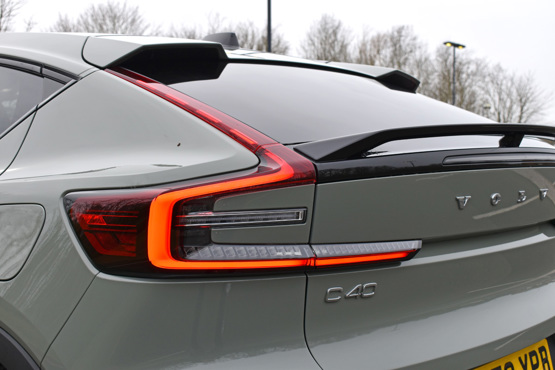
Our car is the C40 Recharge RWD Ultimate 69kWh model, costing £57,555 on the road. Had we taken delivery of a brand-new model, it would be badged EC40, as Volvo has just renamed the car to fit its ‘E’ nomenclature.
In ‘C’ format, Ultimate trim topped the range, which started with the well-equipped £48,355 Core. They sandwiched the £53,850 Plus.
However, as the rebadged EC40, the car is available in just two trims: Plus and Ultra. And only the Plus now comes with our single motor standard battery (starting price of £52,555); Ultra is the extended range or twin motor only and starts at £58,355 for the extended rising to £61,855 for the twin.
Overlooking the fact that our car is no longer available in this trim/battery combination, the single motor option has 66kWh of usable capacity.
Charging time is 34 minutes for 10-80% fill on 130kW charger, while zero-to-full on an 11kW charge point takes from 11 hours.
Confusingly, electric efficiency is “up to 3.8mi/kWh”, according to the spec sheet from Volvo. Confusing, because that would give a theoretical maximum range of 250 miles from a 66kWh battery – it would need to average almost 4.5mi/kWh to get 296 miles of range. After a couple of weeks, we’re averaging 3.08mi/kWh.
Volvo has confirmed the figures are correct but has yet to clarify the apparently oddity. We’ve used this calculation on previous BEVs with complete accuracy.
Standard kit on all C40s includes nine-inch touchscreen with voice activated control, Google Automotive Services, including Google Maps, access to apps and four years’ data allowance, Volvo Cars app for remote functionality, City Safety (pedestrian/cyclist detection, front collision warning with automatic emergency braking), Pilot Assist, driver awareness (blind spot alert with steer assist, cross traffic alert with autobrake, rear collision warning and mitigation), Lane Mitigation assistance, Run-off Road Protection which tightens the seatbelts if the car leaves the road, front/rear parking sensors and rear parking camera.
Exclusive to the Ultra are: Active Bending Pixel LED headlights with cleaning system, cornering fog lights, 12-speaker Harmon Kardon sound system, 360-deg surround view camera and power folding rear seat headrests.
First impressions are good: the car feels smooths, it is easy to drive, and it looks fetching in its zero-cost sage green metallic paintwork.
Specs
| Manufacturer | Volvo |
| Model | C40 Estate |
| Specification | Volvo C40 Estate 175kW Recharge Ultimate 69kWh 5dr Auto |
| Model Year | 2022.00 |
| Annual VED (Road tax) | £10 |
| BIK List Price | £57,500 |
| Range | 295.80mile(s) |
| CO2 | N/A |
| BIK Percentage | 2% |
| Insurance Group | N/A |
| CC | 1 |
| Fuel Type | Electric |
| Vehicle Type | Compact SUV |
| Luggage capacity (Seats up) | 413litres |
| Doors | 5 |
Running Costs
| P11D | £57,500 |
| Cost per mile | 73.50ppm |
| Residual value | £17,150 |
| Insurance group | N/A |
| Fuel Type | Electric |
| Cost per mile | 324.61ppm |
| Fuel | 2.34ppm |
| Depreciation | 320.05ppm |
| Service maintenance and repair | 2.22ppm |
Rivals
Info at a glance
-
P11D Price
£57,500
-
MPG
N/A (WLTP) -
CO2 Emissions
N/A -
BIK %
2% -
Running cost
3 Year 60k : £17,150 4 Year 80k : £14,000 -
Fuel Type
Electric -
Range
295.80mile(s)



